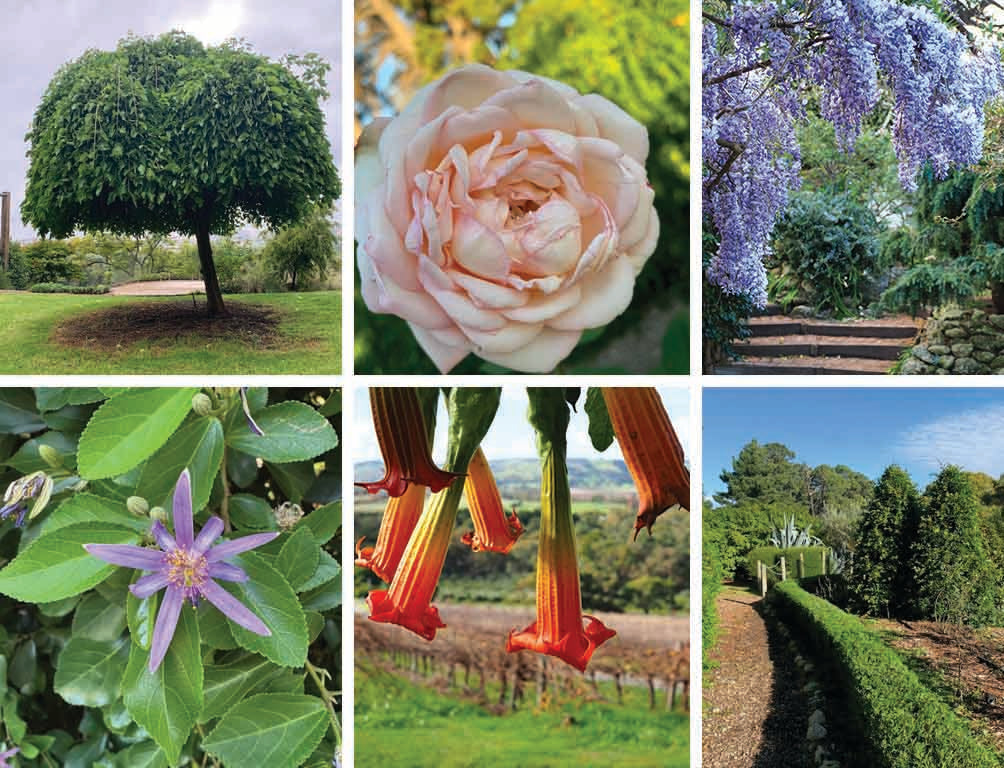
The Must-See Plants of Tipsy Hill Estate: Discover Our Most Iconic Plants!
THE ICONIC PLANTS OF TIPSY HILL
We are lucky enough to have an amazing array of plants at Tipsy Hill Estate, creating a stunning backdrop to our vineyard and a haven for local wildlife. When we host garden tours, visitors are often captivated by the vibrant colors, unique textures, and striking forms of our plants—and we frequently get asked, What is that plant? So, we’ve put together a guide to some of the most iconic and interesting plants you’ll find at Tipsy Hill. Whether they’re rare, resilient, or simply beautiful, these plants help make our estate a truly special place.
For a PDF of this guide with images click HERE
Agonis Flexuosa Variegata (Variegated weeping peppermint)
This Western Australian native is a variegated cultivar of the Weeping Peppermint. The one at Tipsy Hill is located between the house and the garage. This striking tree is stunning to look at and grows well in our hot dry climate. These plants are drought-tolerant and this cultivar is also salt-tolerant which is perfect for our location. Occasionally some non-variegated (green) leaves appear, which we remove because these are more hardy that the variegated form, so we remove them before they begin to dominate the plant.
Rosa Tipsy Imperial Concubine (Tipsy Imperial Concubine Rose)
The name from which Tipsy Hill Estate originates. This 6th century tea rose was named after the Yan Guifei, the beloved concubine of Emperor Xuanzong of the Tang Dynasy. The story goes that she was walking through the Emperors garden and smelt this particular rose and became light-headed or ‘tipsy’ because of its intoxicating scent.
Our Tipsy Imperial Concubine Roses are currently located in the rose bed on the south side of the garden next to the lilly pilly topiary cones. This garden bed gets very hot in summer so we are looking to transplant these roses to a cooler area over the next year or so.
Xanthorrhoea quadrangulata (Grasstree)
This native South Australian grasstree is located at the south western corner of the garden. We have heard that it was the most expensive plant purchased by the previous owner and we have been told it is around 300 years old. It was quite sick when we purchased Tipsy Hill in 2016 because the bed where it grows was very wet and these plants are very susceptible to root rot.
Duranta erecta (Duranta)
We have a number of Duranta plants around the garden in both purple and white. The hedge that runs along the west boundary of Tipsy Hill is a Duranta, we give this hedge a heavy prune in winter and then a number of lighter trims over summer. This hedge is now over 20 years old and we are in the process of thinning out some of the dead wood at the bottom of the hedge plants. The Duranta plants around the garden (such as near the Washbowl area) we have taken off the lower branches so it takes on more of a tree form (as opposed to a bush).
Brugmansia Solanaceae (Angel’s trumpet)
These striking orange flowers add some colour to the gardens here, especially in winter – however be aware, this plant is extremely toxic. So please only view this plant and do not touch!
Melaleuca nesophila (Little Nessie)
We have a number of these plants around the garden, they work well for topiary and also small hedges. They are a great alternative to box hedge. We have a Japanese box hedge under some Yucca plants on the western boundary and I took cuttings from these which I propagated then grew them to a good size before planting along the path next to the Tipsy Imperial Concubine Roses, unfortunately all but two (that were in the shade) died over summer, so I started again and propagated Little Nessies and then planted them in this area, and as you will see they are loving it there!
Wisteria sinensis (Chinese wisteria)
We are lucky enough to have a number of Wisteria vines around the garden including a number of plants around the house. These are in full flower in September and the effect around the house is stunning.
There is a very large Wisteria plant covering the arbour on the south side of the house, this is a Japanese wisteria and does not flower as prolifically as the Chinese variety.
Grewia occidentalis (Crossberry)
This is a shrub I am often asked what it is because of it’s small but interesting looking purple flowers. Our plant is located opposite the garage, next to the Shasta Daisies. This evergreen shrub is native to Southern Africa and copes well with drought conditions.
Morus alba Pendula (Weeping mulberry)
This Weeping mulberry, located on the south lawn is very happy here! We recently had to cut it back and removed around 1m of growth from around the outside as well as ‘lifting her skirt’ so the view over the Adelaide Hills can be appreciated from across the lawn.
Syzygium austral (Lilly pilly straight and narrow)
Those who have visited the garden before would be familiar with the distinctive avenue along the driveway making it easy to spot Tipsy Hill from the road. For over 20 years this avenue of trees was pencil pines, however as these got older and as our environment becomes more extreme, these trees became more susceptible to borers. They required more and more water, regular insecticide application and constant maintenance to remove the dead patches. We decided to call it a draw with them and replace them with something that was more suited to our climate. We selected another evergreen with an upright form, this is the Lilly pilly straight and narrow. They have now been in the ground for 3 years and are doing very well.